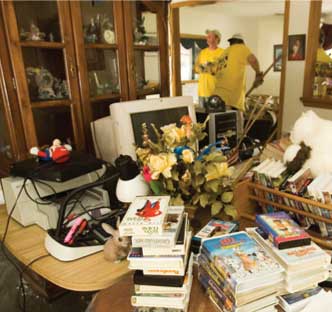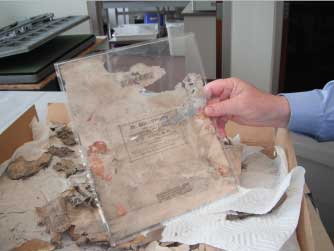Preserving the Past from Peril
Steps to prevent and repair damage
Preventing Damage
There are many different types of disasters that we should prepare for and all types of damage that can result from said disasters. However, the most devastating damage, and the most prolific, is water damage. Many types of disasters include water in one way or another. Flooding may be the most obvious cause of water damage, but hurricanes, tornados, fires, and even earthquakes can result in water damage. In all of our preparations, we should be sure to keep water in mind. Here are a few tips to help you prevent water damage to your photographs and personal records:

Plan Ahead
As you prepare your items for storage you must know what you have and where it is. Make a list of your items and set a rank of priority so you know what is most important. This priority might be set by personal and/or monetary significance of the item.
Secure Top Priorities First
You can use the list you just created to determine where you might store certain items. The higher priority items could be kept by an exit for quick removal or firmly secured, whether they are in storage or on display.
Additional Guidelines
Always try to keep things off the floor. You may also want to look at the types of materials the items are made out of. Stack items that are more susceptible to water damage (paper, textiles, and leathers) higher than those items that are not (glass, metal, and high fired ceramics). Regardless of material, try to store items in boxes or other containers as this provides an additional protective barrier.
Recovering Water Damaged Items
Even when we prepare, damage can still occur. Here are some tips on how to recover water damaged items:

Removing
Flood water can contain hazardous material. Always use gloves and other protective gear.
Prioritize the order in which you remove items from the water. Contaminants (insecticides/herbicides, unstable ink, or dye) and water sensitive items (paper, textiles, and low fired ceramics) should be removed first.
When removing items it may be necessary or beneficial to use some kind of a support such as window screening, sew on interfacing, or white scrap fabric to lift and remove items from the water.
After a flood you don't have much time to save what you can. It is vital to have a plan before hand, then when the time comes act quickly and safely to save your history.
Drying
Drying is a very important and delicate step in recovering items. Some items should be dried quickly using absorbent toweling and good air circulation. These types of items include paper, textiles, metals and glass. Sometimes fans are appropriate but shouldn't be used on fragile items. Heaters should not be used as they promote mold growth.
Items such as wood should be dried slowly to prevent over-drying. One way to slow-dry is by wrapping the item in plastic, then slowly opening and re-wrapping the plastic over a number of days.

Shaped items (clothes and leather) can become distorted. To prevent this, stuff them with absorbent toweling to maintain the original shape. Taxidermy, especially historic taxidermy, often contains hazardous chemicals and insecticides. Handle carefully and wear protective gear.
Photographs and electronic media can pose special problems. Photographic emulsions can become damaged if touched while wet. Carefully handle photographs by their outside edges and hang or lay flat to dry. Do not stack photographs as they will stick together. Digital photography should be treated like paper. Electronic media, negatives, and other items you are not sure about should be transferred to clean water in a zippered bag and taken to a professional conservator.
Books, paper, most textiles, and photographs may be temporarily frozen to accommodate time issues.
Contact a conservator
If you have further questions or specific concerns, consult a conservator. You can find a conservator by asking a librarian at the Church History Library.